
Dendrophryniscus is a genus of true toads in the family Bufonidae, sometimes known as tree toads. They are endemic to the Atlantic Forest of Brazil.

Leptopelis is a genus of frogs in the family Arthroleptidae. They are found throughout Sub-Saharan Africa, excluding Madagascar. It is placed in monotypic subfamily Leptopelinae, although this subfamily is not always recognized. They have a number of common names, including forest treefrogs, tree frogs, leaf-frogs, and big-eyed frogs.
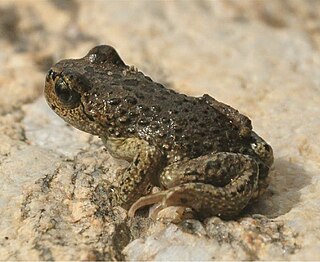
Scutiger boulengeri is a species of toad in the family Megophryidae. It is found in Nepal, India (Sikkim) and western China. A healthy population has been found at an elevation of 5,270 m (17,290 ft) in one of the lakes in the Gurudongmar Lake complex in Sikkimese Himalaya. This is one of the highest elevations where amphibians have ever been recorded.
Rhinella chrysophora, sometimes known as the Rio Viejo toad, is a species of toad in the family Bufonidae. It is endemic to the Cordillera Nombre de Dios on the Atlantic versant in north-central Honduras.
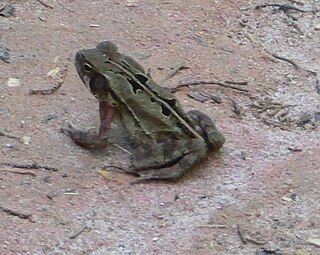
Rhinella crucifer is a species of toad in the family Bufonidae. It endemic to Brazil and known from the Atlantic Forest of eastern Brazil between the states of Ceará in the north and Rio de Janeiro in the south. Common name striped toad has been coined for it. "Rhinella pombali" is a hybrid between Rhinella ornata and this species.
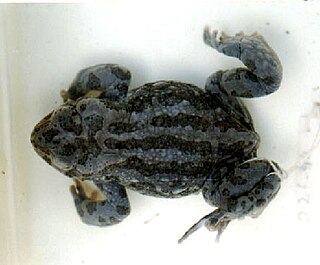
Bufotes latastii, commonly known as the Baltistan toad, Ladakh toad or vertebral-banded toad, is a species of toad in the family Bufonidae. It is found in the West Himalayan region at altitudes of 780–3,200 m (2,560–10,500 ft) from northern Pakistan to Ladakh in India; although sometimes reported elsewhere, this is the result of misidentifications of other species. It is found in alpine forests, coniferous forests, grasslands, paddy fields, mountain desert and roadsides. It often lives near water, like lakes and ponds, in the riparian growth. It can be beneficial to humans as it feeds on insects and their larvae within areas of agriculture.

The South American common toad is a species complex of toads in the family Bufonidae. They are found throughout the Amazonian South America and eastern Panama. It was originally believed to be a single species, but is now known to represent a complex of more than one.

Rhinella poeppigii is a species of toad in the family Bufonidae that is known from the eastern Andean slopes of Ecuador, Peru, and Bolivia, as well as from Serranía de Sira in Amazonian Peru. Its distinctiveness from Rhinella marina has been debated, but it is currently accepted as a valid species. It is named after Eduard Friedrich Poeppig, German botanist and naturalist who made scientific expeditions to South America.
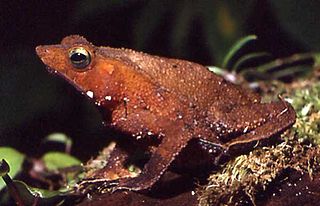
Rhinella proboscidea is a species of small South American toad in the family Bufonidae, common in the Amazon rainforest. It is the only species known to practice reproductive necrophilia.
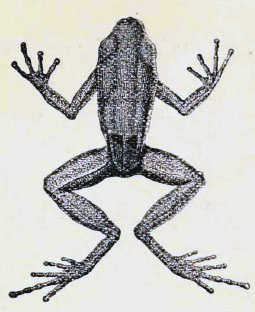
Hyloxalus whymperi, sometimes known as the Tanti rocket frog, is a species of frog in the family Dendrobatidae. It is endemic to west-central Ecuador and only known from Tanti and near San Francisco de Las Pampas, Pichincha Province. It is a poorly known species.
Leptopelis boulengeri is a species of frog in the family Arthroleptidae. It is found in southeastern Nigeria, southern Cameroon, Equatorial Guinea, Gabon, Republic of the Congo, and western Democratic Republic of the Congo. It is expected to be found in the Central African Republic and the Cabinda Enclave of Angola. Common name Victoria forest treefrog has been coined for it, apparently in reference to its type locality, "Victoria, Kamerun", now known as Limbe.

The Tai forest tree frog is a species of frog in the family Arthroleptidae. It is found in Liberia, southern Ivory Coast, and Ghana. Records from Nigeria are controversial and may refer to other species, possibly Leptopelis boulengeri.

Cryptobatrachus boulengeri, also known as Boulenger's backpack frog, is a species of frogs in the family Hemiphractidae. It is endemic to Sierra Nevada de Santa Marta in northern Colombia. The specific name honours George Albert Boulenger, an eminent herpetologist.

Nannophrys guentheri is an extinct species of frog in the family Dicroglossidae. It was endemic to Sri Lanka. The species was first identified in 1882 by George Boulenger and named after the German-born British zoologist Albert Günther. It is not known where in Sri Lanka the specimens were found.
Cornufer boulengeri, commonly known as Boulenger's wrinkled ground frog or Boulenger's platymantis, is a species of frog in the family Ceratobatrachidae. It is endemic to New Britain Island in the Bismarck Archipelago, Papua New Guinea. It has been observed as high as 1500 meters above sea level. The adults live on the forest floor of lowland and foothill rain forests, whereas juveniles occur low on the vegetation. It is potentially threatened by habitat loss caused by logging.
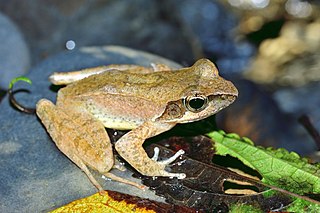
Rana sauteri is a species of true frog endemic to Taiwan. It inhabits low-altitude hill forests and the associated streams. It is an endangered species threatened by habitat loss due to agriculture and infrastructure development. Common names recorded for Rana sauteri include Kanshirei Village frog, Taiwan groove-toed frog, Sauter's brown frog, and Taiwan pseudotorrent frog.

Morethia boulengeri is a species of lizard in the family Scincidae. The species is endemic to Australia.

Amazophrynella is a genus of toads in the family Bufonidae. They are found throughout the Amazon Basin.
Dendrophryniscus skuki is a species of toad in the family Bufonidae. It is endemic to northeastern Brazil and only known from its type locality in the municipality of Itacaré, state of Bahia. This species is dedicated to herpetologist Gabriel "Gabo" Skuk, the species describer's friend who perished in a diving accident.
Enyalius boulengeri, also known commonly as the Brazilian fathead anole, is a species of lizard in the family Leiosauridae. The species is endemic to Brazil.
















